Dynamic responses of an inclined fgsw beam traveled by a moving mass based on a moving mass element theory
Abstract. Dynamic analysis of an inclined functionally graded sandwich (FGSW) beam
traveled by a moving mass is studied. The beam is composed of a fully ceramic core and
two skin layers of functionally graded material (FGM). The material properties of the FGM
layers are assumed to vary in the thickness direction by a power-law function, and they
are estimated by Mori–Tanaka scheme. Based on the first-order shear deformation theory,
a moving mass element, taking into account the effect of inertial, Coriolis and centrifugal
forces, is derived and used in combination with Newmark method to compute dynamic
responses of the beam. The element using hierarchical functions to interpolate the displacements and rotation is efficient, and it is capable to give accurate dynamic responses
by small number of the elements. The effects of the moving mass parameters, material distribution, layer thickness ratio and inclined angle on the dynamic behavior of the FGSW
beam are examined and highlighted.
Keywords: inclined FGSW beam; hierarchical functions;
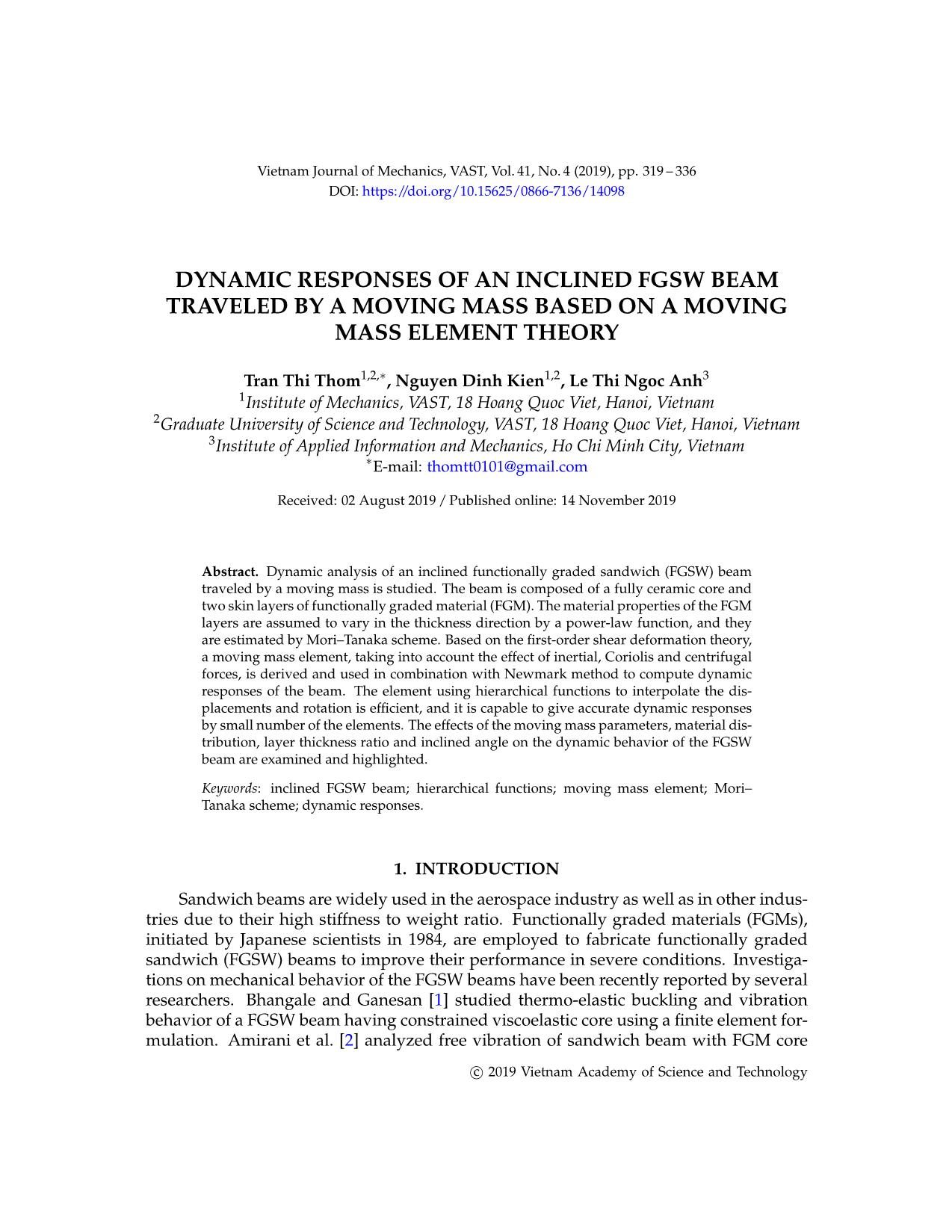
Trang 1
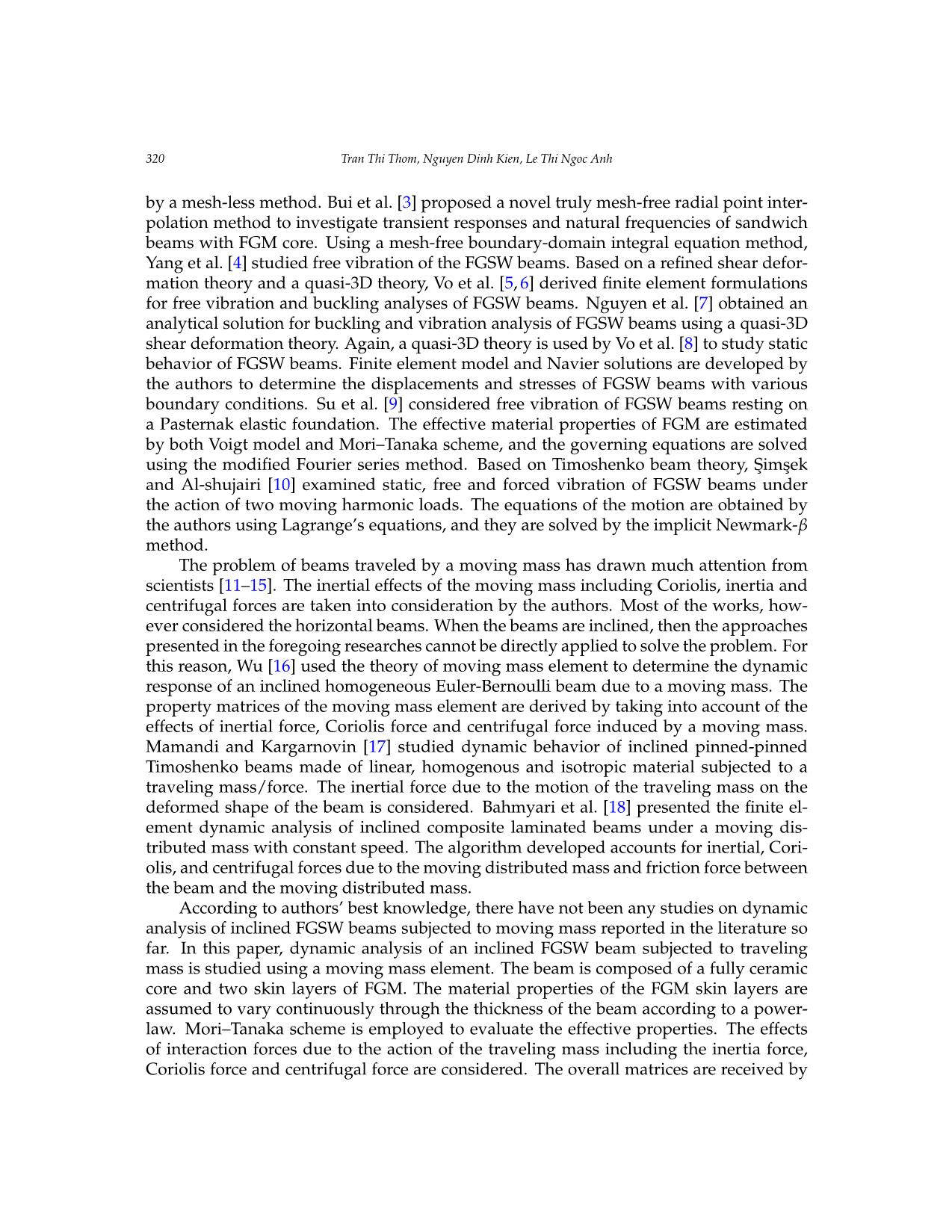
Trang 2
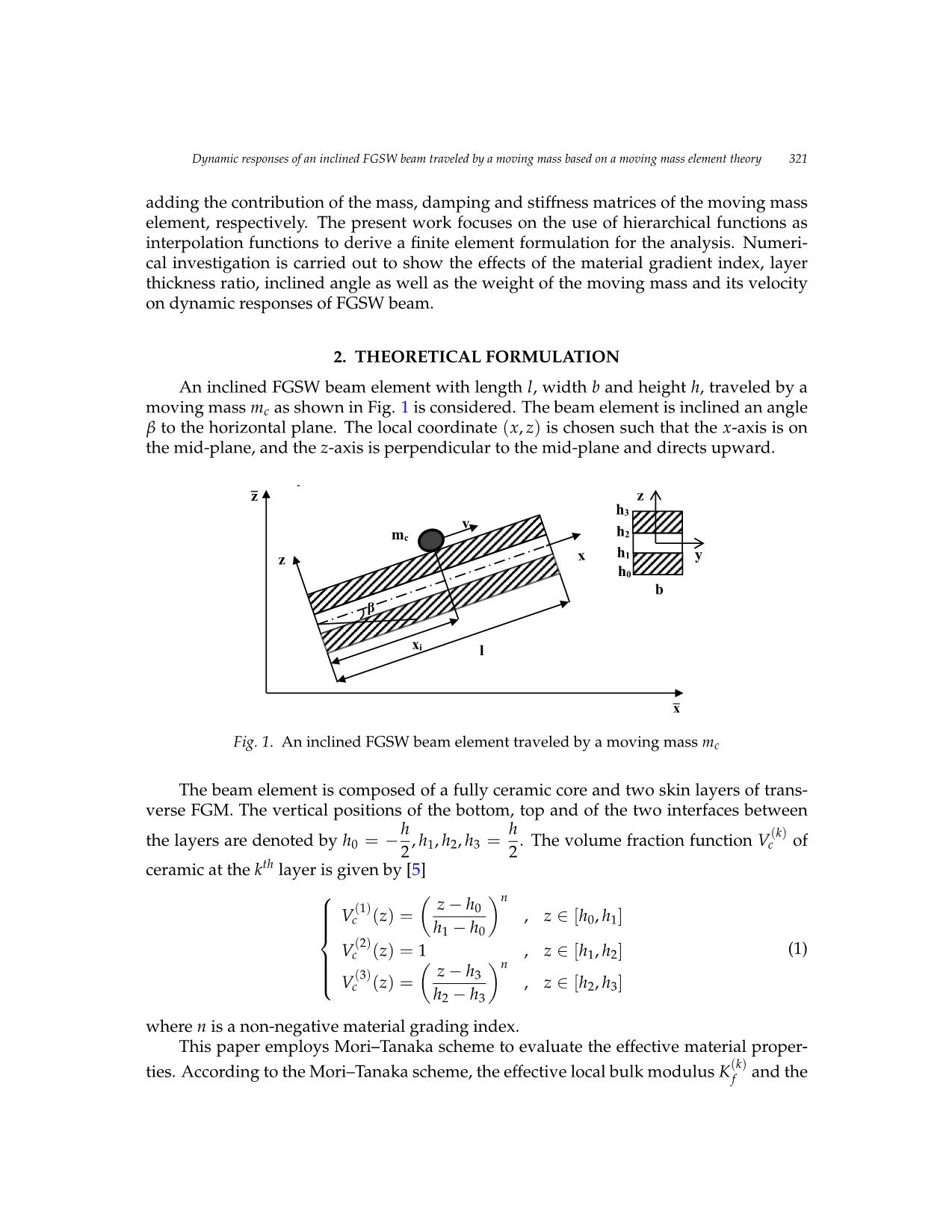
Trang 3
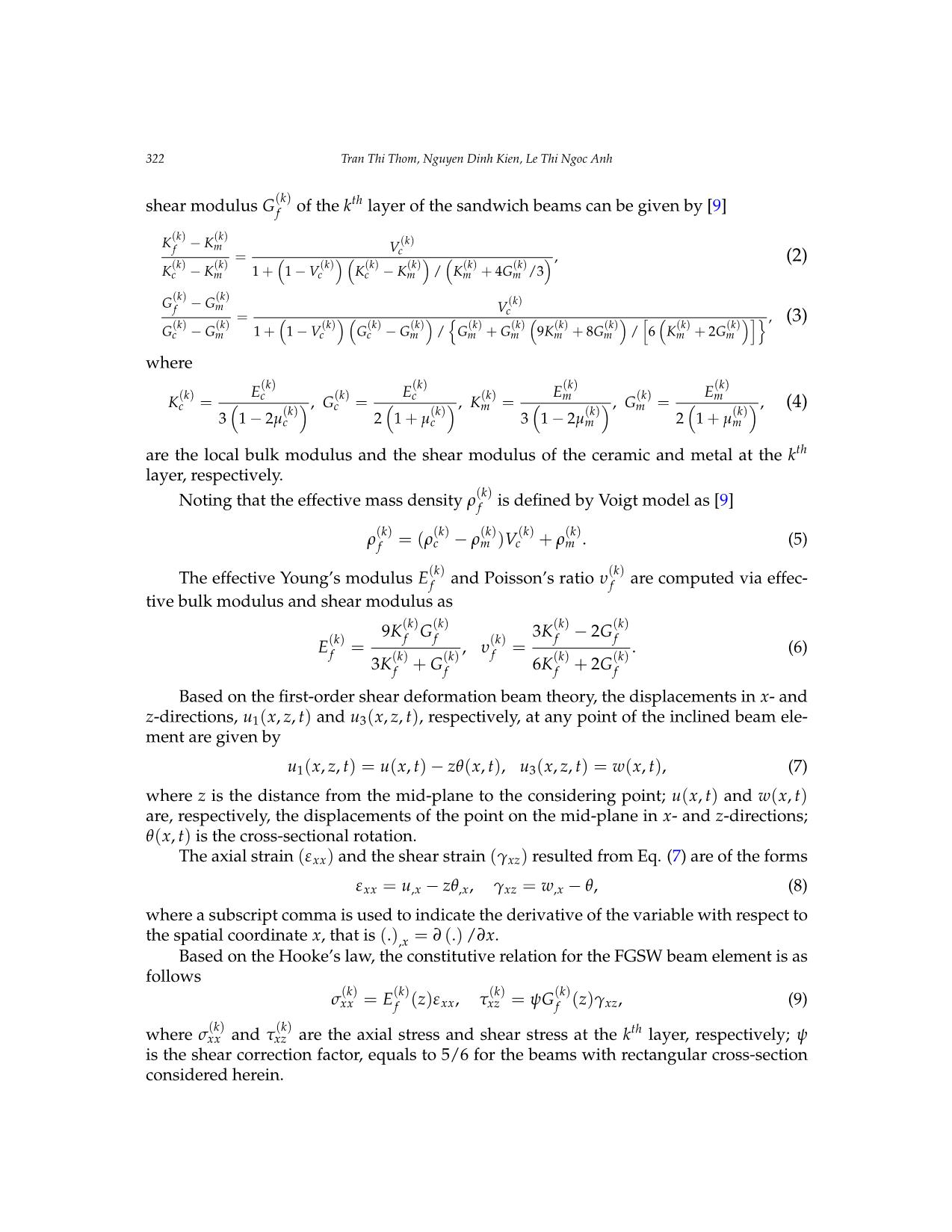
Trang 4
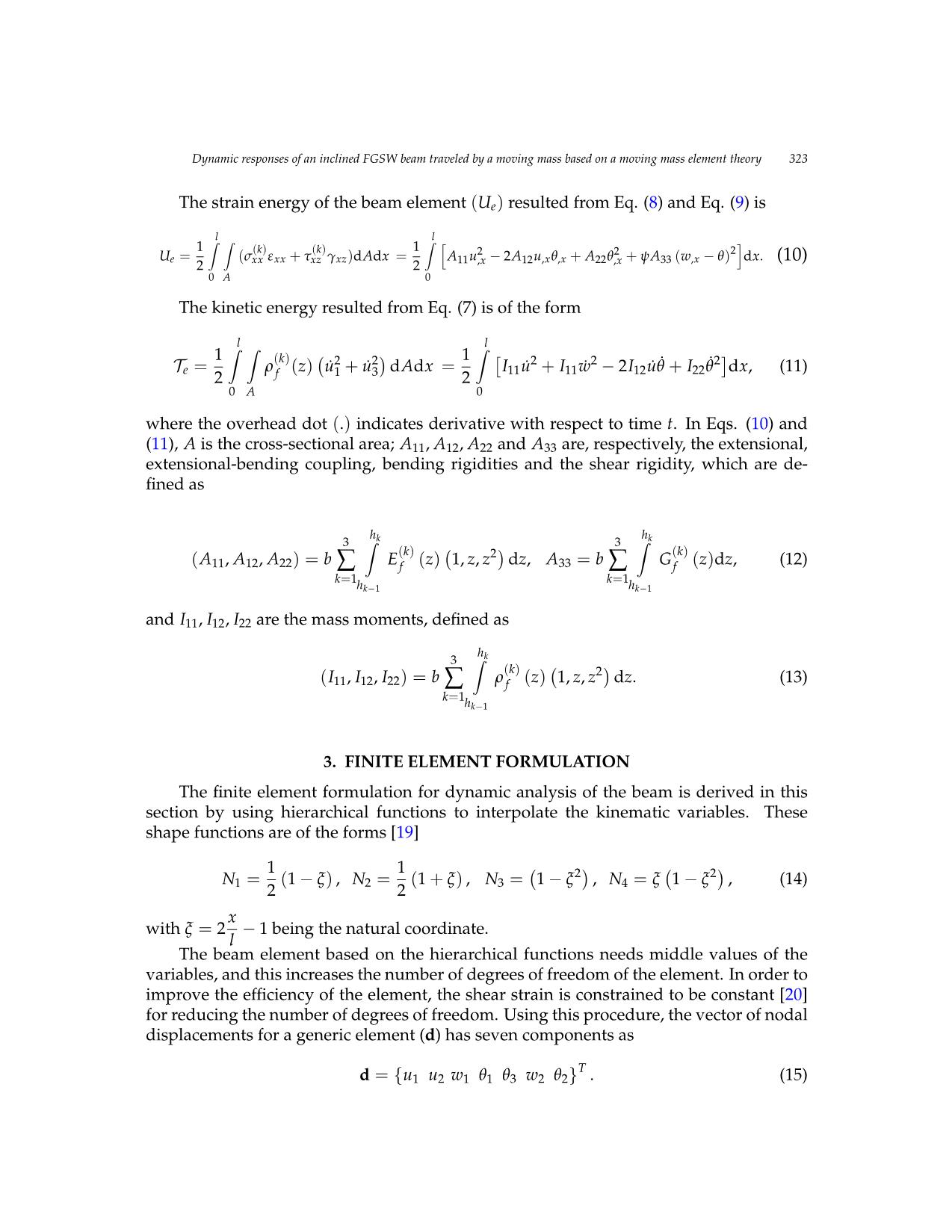
Trang 5
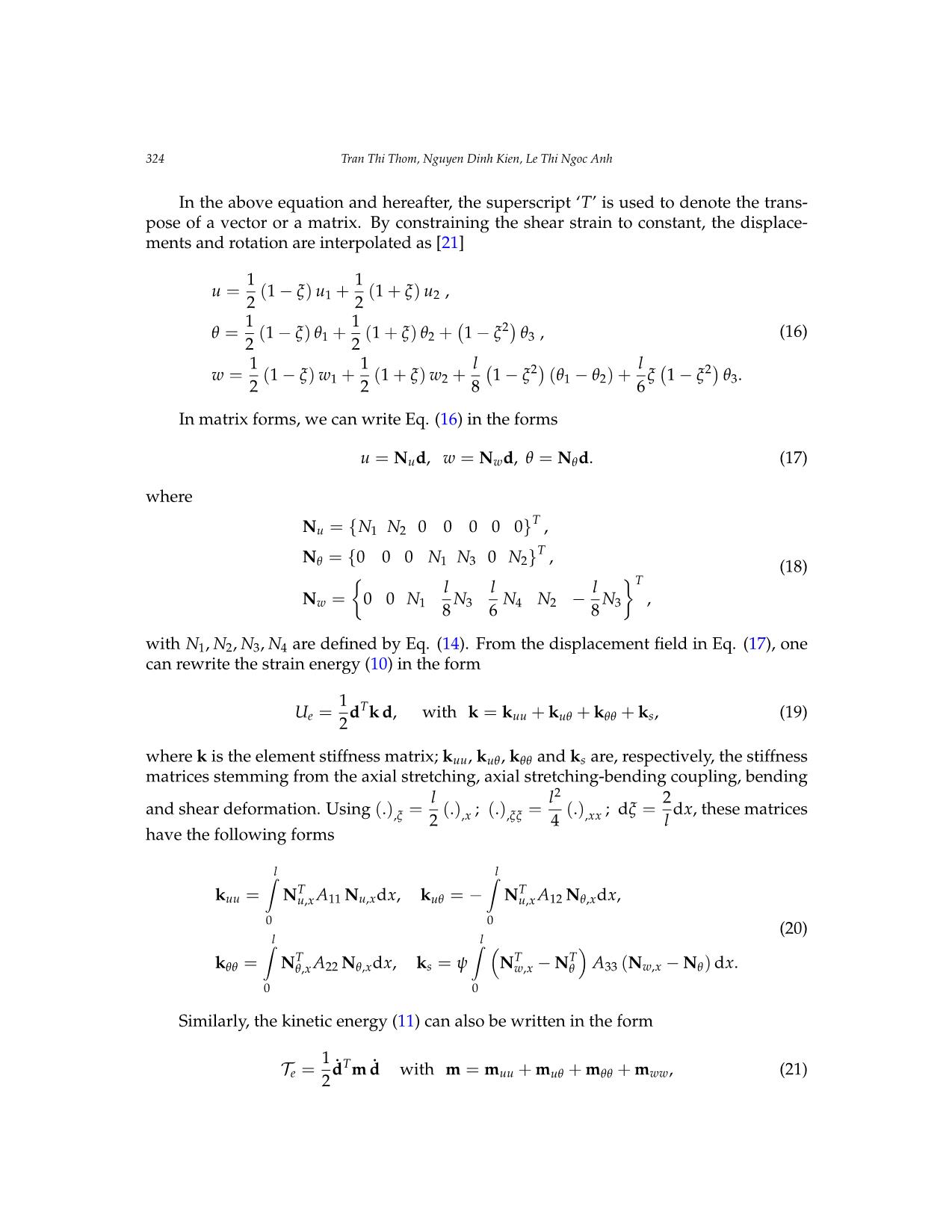
Trang 6
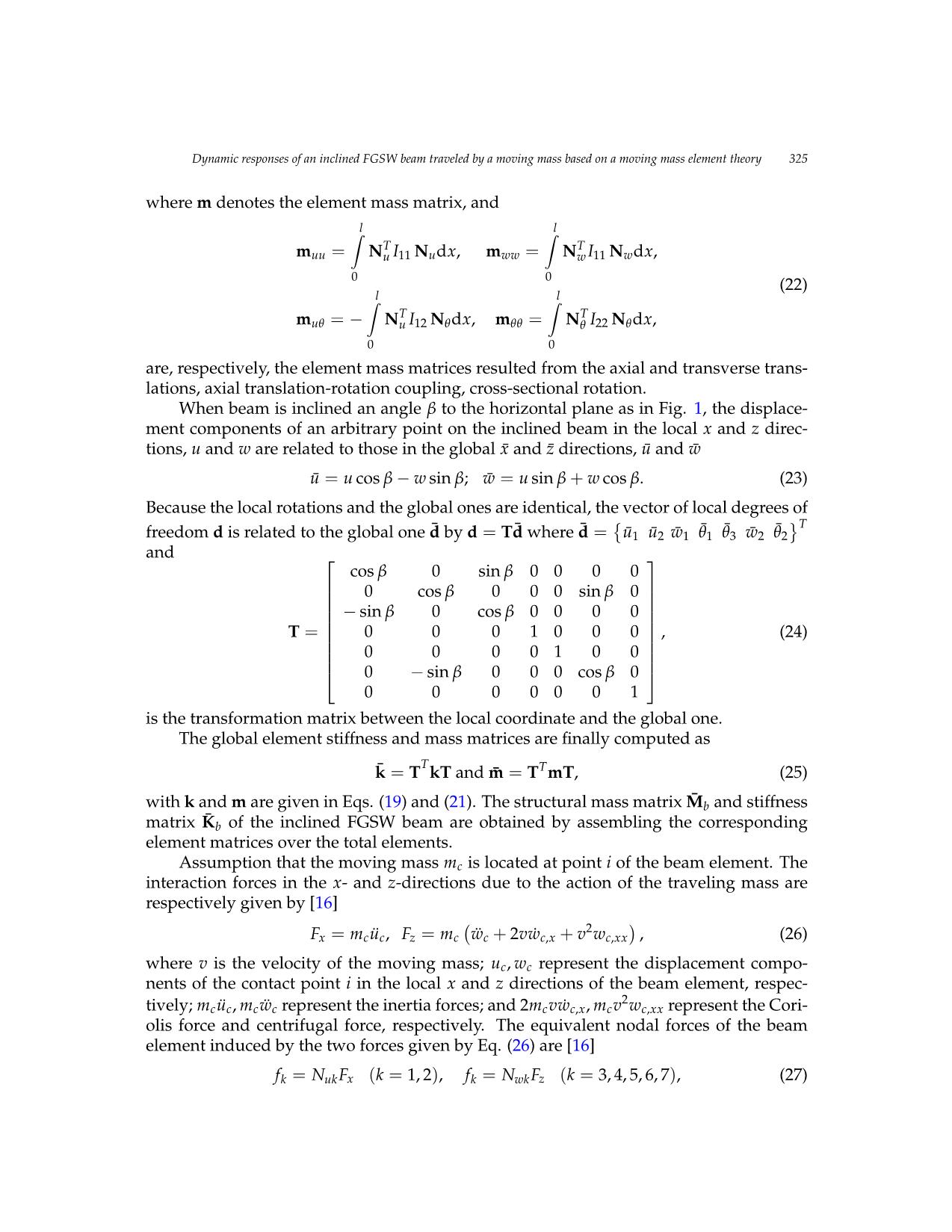
Trang 7
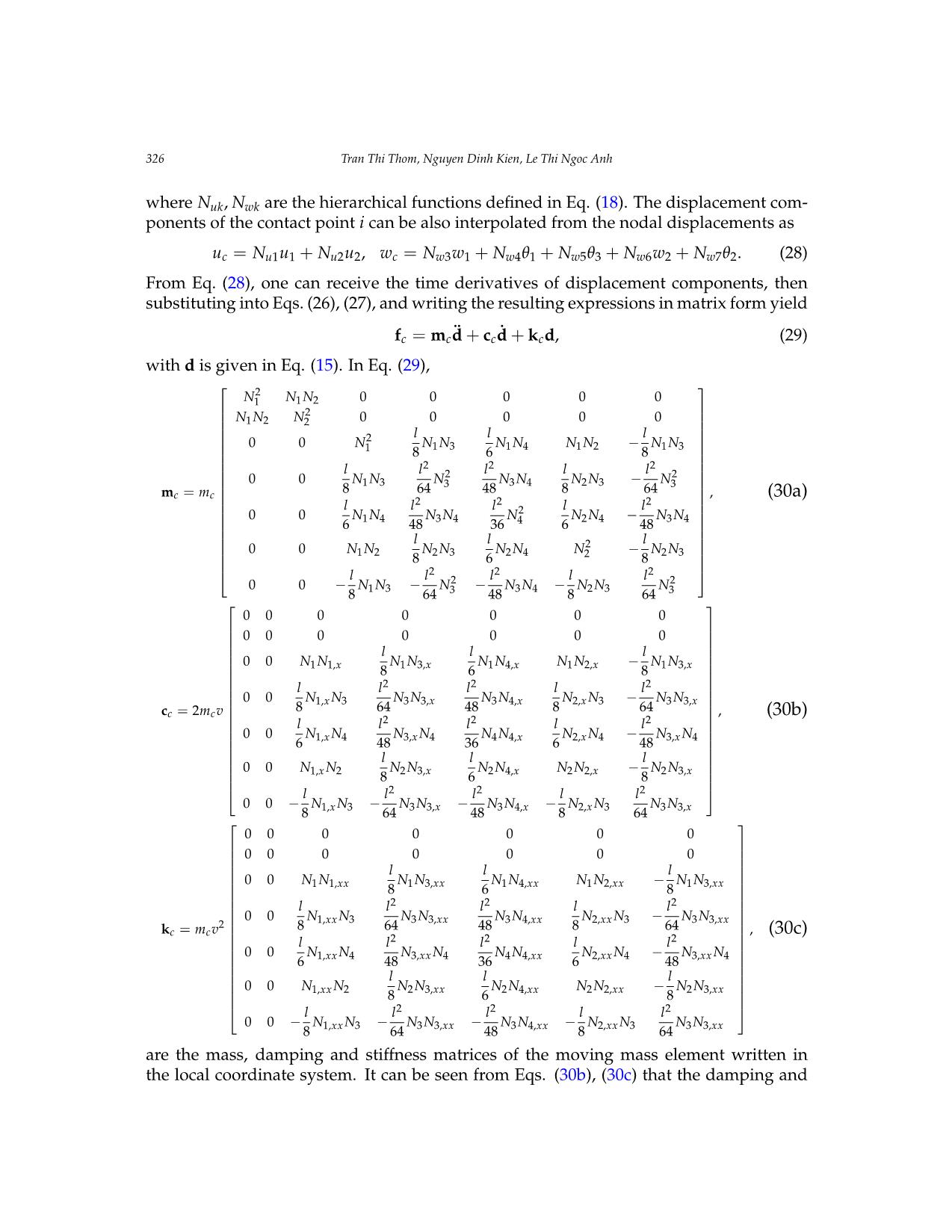
Trang 8
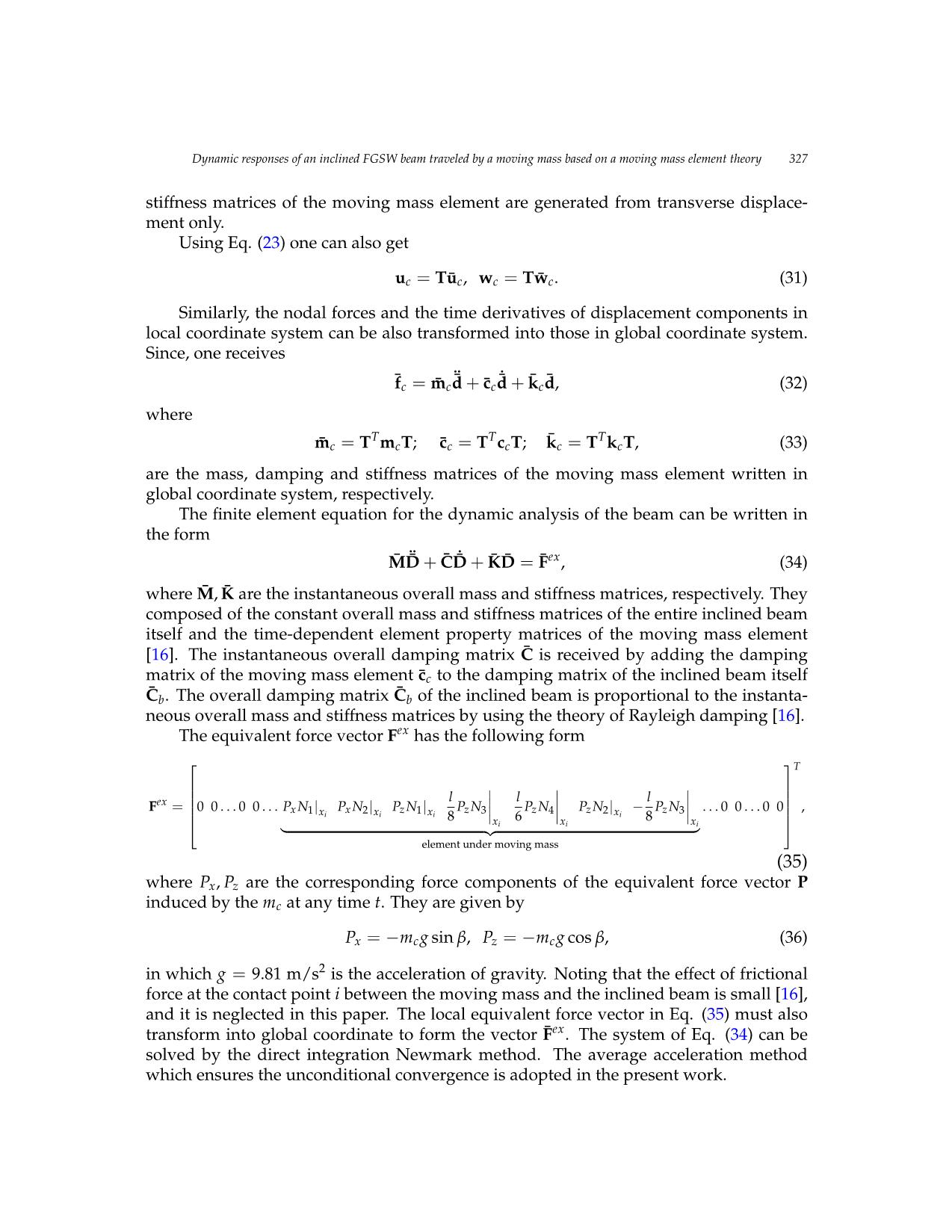
Trang 9
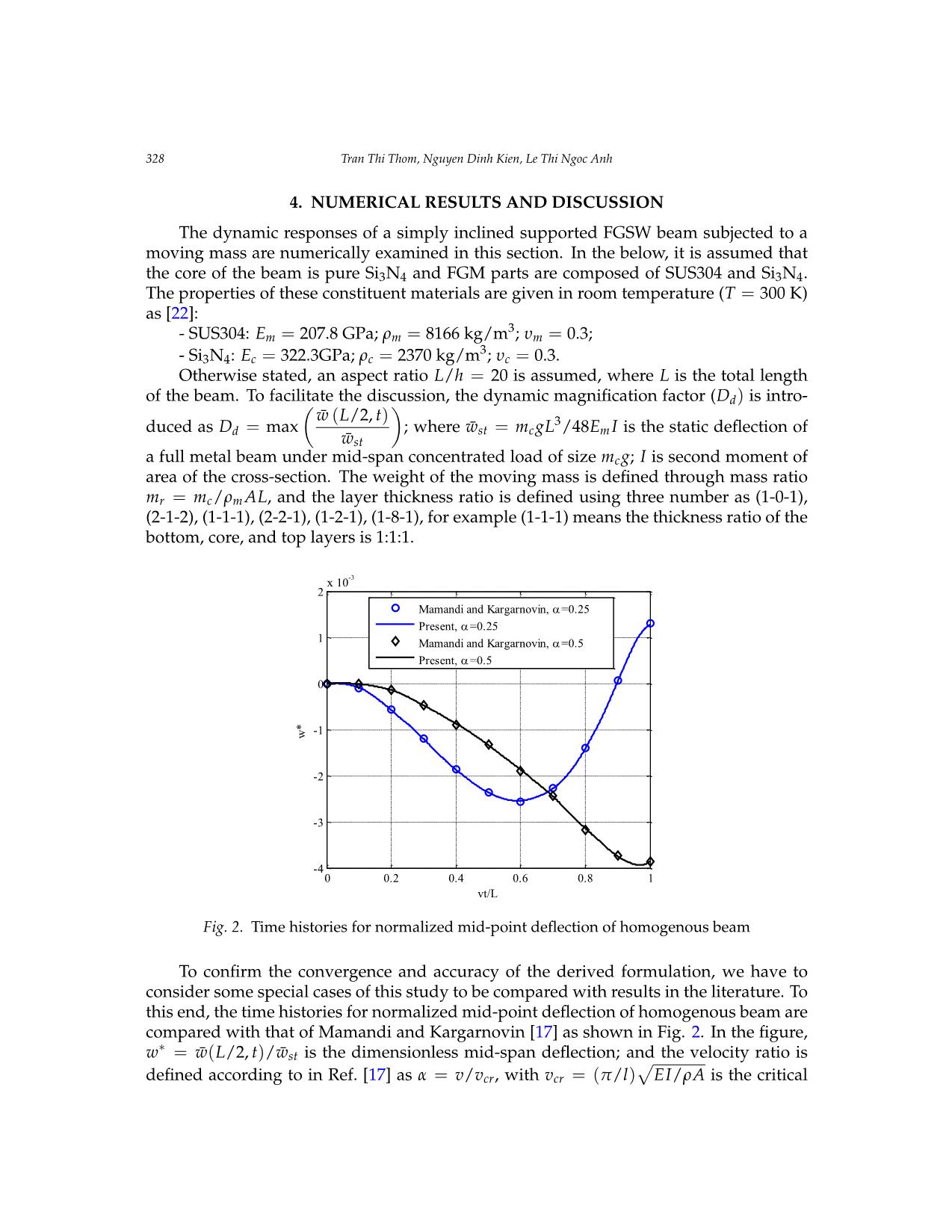
Trang 10
Tải về để xem bản đầy đủ
Tóm tắt nội dung tài liệu: Dynamic responses of an inclined fgsw beam traveled by a moving mass based on a moving mass element theory
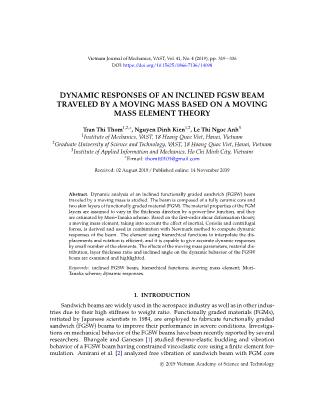
Vietnam Journal of Mechanics, VAST, Vol.41, No. 4 (2019), pp. 319 – 336 DOI: https://doi.org/10.15625/0866-7136/14098 DYNAMIC RESPONSES OF AN INCLINED FGSW BEAM TRAVELED BY A MOVING MASS BASED ON A MOVING MASS ELEMENT THEORY Tran Thi Thom1,2,∗, Nguyen Dinh Kien1,2, Le Thi Ngoc Anh3 1Institute of Mechanics, VAST, 18 Hoang Quoc Viet, Hanoi, Vietnam 2Graduate University of Science and Technology, VAST, 18 Hoang Quoc Viet, Hanoi, Vietnam 3Institute of Applied Information and Mechanics, Ho Chi Minh City, Vietnam ∗E-mail: thomtt0101@gmail.com Received: 02 August 2019 / Published online: 14 November 2019 Abstract. Dynamic analysis of an inclined functionally graded sandwich (FGSW) beam traveled by a moving mass is studied. The beam is composed of a fully ceramic core and two skin layers of functionally graded material (FGM). The material properties of the FGM layers are assumed to vary in the thickness direction by a power-law function, and they are estimated by Mori–Tanaka scheme. Based on the first-order shear deformation theory, a moving mass element, taking into account the effect of inertial, Coriolis and centrifugal forces, is derived and used in combination with Newmark method to compute dynamic responses of the beam. The element using hierarchical functions to interpolate the dis- placements and rotation is efficient, and it is capable to give accurate dynamic responses by small number of the elements. The effects of the moving mass parameters, material dis- tribution, layer thickness ratio and inclined angle on the dynamic behavior of the FGSW beam are examined and highlighted. Keywords: inclined FGSW beam; hierarchical functions; moving mass element; Mori– Tanaka scheme; dynamic responses. 1. INTRODUCTION Sandwich beams are widely used in the aerospace industry as well as in other indus- tries due to their high stiffness to weight ratio. Functionally graded materials (FGMs), initiated by Japanese scientists in 1984, are employed to fabricate functionally graded sandwich (FGSW) beams to improve their performance in severe conditions. Investiga- tions on mechanical behavior of the FGSW beams have been recently reported by several researchers. Bhangale and Ganesan [1] studied thermo-elastic buckling and vibration behavior of a FGSW beam having constrained viscoelastic core using a finite element for- mulation. Amirani et al. [2] analyzed free vibration of sandwich beam with FGM core c 2019 Vietnam Academy of Science and Technology 320 Tran Thi Thom, Nguyen Dinh Kien, Le Thi Ngoc Anh by a mesh-less method. Bui et al. [3] proposed a novel truly mesh-free radial point inter- polation method to investigate transient responses and natural frequencies of sandwich beams with FGM core. Using a mesh-free boundary-domain integral equation method, Yang et al. [4] studied free vibration of the FGSW beams. Based on a refined shear defor- mation theory and a quasi-3D theory, Vo et al. [5,6] derived finite element formulations for free vibration and buckling analyses of FGSW beams. Nguyen et al. [7] obtained an analytical solution for buckling and vibration analysis of FGSW beams using a quasi-3D shear deformation theory. Again, a quasi-3D theory is used by Vo et al. [8] to study static behavior of FGSW beams. Finite element model and Navier solutions are developed by the authors to determine the displacements and stresses of FGSW beams with various boundary conditions. Su et al. [9] considered free vibration of FGSW beams resting on a Pasternak elastic foundation. The effective material properties of FGM are estimated by both Voigt model and Mori–Tanaka scheme, and the governing equations are solved using the modified Fourier series method. Based on Timoshenko beam theory, S¸ims¸ek and Al-shujairi [10] examined static, free and forced vibration of FGSW beams under the action of two moving harmonic loads. The equations of the motion are obtained by the authors using Lagrange’s equations, and they are solved by the implicit Newmark-β method. The problem of beams traveled by a moving mass has drawn much attention from scientists [11–15]. The inertial effects of the moving mass including Coriolis, inertia and centrifugal forces are taken into consideration by the authors. Most of the works, how- ever considered the horizontal beams. When the beams are inclined, then the approaches presented in the foregoing researches cannot be directly applied to solve the problem. For this reason, Wu [16] used the theory of moving mass element to determine the dynamic response of an inclined homogeneous Euler-Bernoulli beam due to a moving mass. The property matrices of the moving mass element are derived by taking into account of the effects of inertial force, Coriolis force and centrifugal force induced by a moving mass. Mamandi and Kargarnovin [17] studied dynamic behavior of inclined pinned-pinned Timoshenko beams made of linear, homogenous and isot ... In Fig. 5, the relation between the dynamic magnification factor Dd and the moving mass velocity is illustrated with different mass ratio and inclined angle of the beam. As seen from the figure, the relation between Dd and v is similar to that of isotropic beams under a moving load, that is, the factor Dd both increases and decreases when the velocity of moving mass is low. When moving mass velocity increases, the factor Dd increases and it reaches a maximum value. This dependency rule is true for any values of the mass ratio and inclined angle of the beam. In addition, the increase in the mass ratio leads to the decrease in the factor Dd and the factor Dd reaches the maximum value at the lower velocity of moving mass. Also, it is seen from this figure that the factor Dd decreases as the inclined angle of the beam increases. 13 Dynamic responses of an inclined FGSW beam traveled by a moving mass based on a moving mass element theory 333 of moving mass is low. When moving mass velocity increases, the factor Dd increases and it reaches a maximum value. This dependency rule is true for any values of the mass ratio and inclined angle of the beam. In addition, the increase in the mass ratio leads to the decrease in the factor Dd and the factor Dd reaches the maximum value at the lower velocity of moving mass. Also, it is seen from this figure that the factor Dd decreases as the inclined angle of the beam increases. m =0.25 m =0.5 m =0.75 m =1 r r r r 2.5 2.5 (a) =0 (b) = /12 2 2 d 1.5 d 1.5 D D 1 1 0.5 0.5 50 100 150 200 250 300 0 50 100 150 200 250 300 v (m/s) v (m/s) 2.5 2.5 (c) = /6 (d) = /4 2 2 d d 1.5 1.5 D D 1 1 0.5 0.5 0 50 100 150 200 250 300 0 50 100 150 200 250 300 damping and stiffness matricesv (m/s) of the moving mass element generated by the vinteraction (m/s) forces including the inertia force, Coriolis force and centrifugal force. These matrices must be added to the corresponding onesFig. 5.of Variationthe entire of inclined the dynamic beam magnification itself to receive factor ofthe (1 instantaneous-2-1) beam with overall different mass, mass damping ratio and andinclined stiffness angle: Fig. 5. Variationmatrices.n=1 of The the system dynamic of motion magnification equations is solved with factor the aid of of (1-2-1) Newmark beam method. withThe accuracy different of the mass ratio derived formulation was validated by comparing the numericaln results= obtained in the present paper with the availableIn Fig. data 6 and in theFig. literature. 7, the thicknessand The numerical inclined distribution results angle: of showthe normalized a clear effect1 axial of stressthe gradient at mid index,-span sectionthe layer of thickness(1-1-1) beam ratio, and moving (4-2- 1)mass beam speed, are depicted mass ratio for and various the inclined values ofangle inclined of th eangle beam of on the the beam dynamic with responsev=30 m/s ofand the v =100beam. m/s, respectively. The stress in these figures was computed at the time when the moving mass arrives at the mid-span of the inclined beam, and it was normalized as / , where = PLh/8I, 0.5 0.5 xx 0 0 P=100 kN. At a given value of moving mass velocity, the maximum amplitude of both the compressive =0 =0 and tensile stresses decrease as the inclined angle of the beam increases. Thus, by raising the inclined angle of the beam, we could= /12 decrease not only the dynamic magnification factor,= /12but also the maximum amplitude of 0.25the axial stress.= Specially, /6 it can be observed from these0.25 figures that =in /6the case beam is unsymmetrical (Fig. 6b, 7b), the stress= /4 does not vanish at the mid-span. = /4 5. CONCLUSION 0 0 z/h z/h The dynamic analysis of an inclined FGSW beam subjected to moving mass is studied using the first- order shear deformation theory. The effective material properties of FGSW beam are estimated by Mori– T-0.25anaka’s scheme. The hierarchical functions are used to-0.25 interpolate the displacements at the contact point i between the moving mass and beam element, and these shape functions are also used to interpolate the kinematic variables of the beam. The theory of moving mass element has been used to establish the mass, (a) (1-1-1) (b) (4-2-1) -0.5 -0.5 -10 -5 0 5 10 14 -10 -5 0 5 10 * * Fig. 6. Thickness distribution of normalized axial stress at mid-span section of inclined FGSW beam with different Fig. 6. Thickness distribution of normalizedinclined angle: axial v=30 m/s, stress n=1, mr=0.5 at mid-span section of inclined FGSW beam with different inclined angle: v = 30 m/s, n = 1, mr = 0.5 0.5 0.5 =0 =0 = /12 = /12 0.25 = /6 0.25 = /6 = /4 = /4 0 0 z/h z/h -0.25 -0.25 (a) (1-1-1) (b) (4-2-1) -0.5 -0.5 -10 -5 0 5 10 15 -10 -5 0 5 10 15 * * Fig. 7. Thickness distribution of normalized axial stress at mid-span section of inclined FGSW beam with different inclined angle: v=100 m/s, n=1, mr=0.5 15 damping and stiffness matrices of the moving mass element generated by the interaction forces including the inertia force, Coriolis force and centrifugal force. These matrices must be added to the corresponding ones of the entire inclined beam itself to receive the instantaneous overall mass, damping and stiffness matrices. The system of motion equations is solved with the aid of Newmark method. The accuracy of the derived formulation was validated by comparing the numerical results obtained in the present paper with the available data in the literature. The numerical results show a clear effect of the gradient index, the layer thickness ratio, moving mass speed, mass ratio and the inclined angle of the beam on the dynamic response of the beam. 0.5 0.5 =0 =0 = /12 = /12 0.25 = /6 0.25 = /6 = /4 = /4 0 0 z/h z/h -0.25 -0.25 (a) (1-1-1) (b) (4-2-1) -0.5 -0.5 -10 -5 0 5 10 -10 -5 0 5 10 * * 334Fig. 6. Thickness distribution Tran Thiof normalized Thom, Nguyen axial stress Dinh at mid Kien,-span Lesection Thi of Ngoc inclined Anh FGSW beam with different inclined angle: v=30 m/s, n=1, mr=0.5 0.5 0.5 =0 =0 = /12 = /12 0.25 = /6 0.25 = /6 = /4 = /4 0 0 z/h z/h -0.25 -0.25 (a) (1-1-1) (b) (4-2-1) -0.5 -0.5 -10 -5 0 5 10 15 -10 -5 0 5 10 15 * * Fig. 7. Thickness distribution of normalized axial stress at mid-span section of inclined FGSW beam with different Fig. 7. Thickness distribution of normalizedinclined angle: axialv=100 m/s, stress n=1, m atr=0.5 mid-span section of inclined FGSW beam with different inclined angle:15 v = 100 m/s, n = 1, mr = 0.5 In Fig.6 and Fig.7, the thickness distributions of the normalized axial stress at mid-span section of (1-1-1) beam and (4-2-1) beam are depicted for various values of inclined angle of the beam with v = 30 m/s and v = 100 m/s, respectively. The stress in these figures was computed at the time when the moving mass arrives at the mid-span ∗ of the inclined beam, and it was normalized as σ = σxx/σ0, where σ0 = PLh/8I, P = 100 kN. At a given value of moving mass velocity, the maximum amplitude of both the compressive and tensile stresses decrease as the inclined angle of the beam increases. Thus, by raising the inclined angle of the beam, we could decrease not only the dynamic magnification factor, but also the maximum amplitude of the axial stress. Specially, it can be observed from these figures that in the case beam is unsymmetrical (Fig.6(b),7(b)), the stress does not vanish at the mid-span. 5. CONCLUSION The dynamic analysis of an inclined FGSW beam subjected to moving mass is stud- ied using the first-order shear deformation theory. The effective material properties of FGSW beam are estimated by Mori–Tanaka’s scheme. The hierarchical functions are used to interpolate the displacements at the contact point i between the moving mass and beam element, and these shape functions are also used to interpolate the kinematic variables of the beam. The theory of moving mass element has been used to establish the mass, damping and stiffness matrices of the moving mass element generated by the interaction forces including the inertia force, Coriolis force and centrifugal force. These matrices must be added to the corresponding ones of the entire inclined beam itself to re- ceive the instantaneous overall mass, damping and stiffness matrices. The system of mo- tion equations is solved with the aid of Newmark method. The accuracy of the derived formulation was validated by comparing the numerical results obtained in the present paper with the available data in the literature. The numerical results show a clear effect of the gradient index, the layer thickness ratio, moving mass speed, mass ratio and the inclined angle of the beam on the dynamic response of the beam. Dynamic responses of an inclined FGSW beam traveled by a moving mass based on a moving mass element theory 335 ACKNOWLEDGMENTS This research is funded by Vietnam National Foundation for Science and Technology Development (NAFOSTED) under Grant Number 107.02-2018.23. The authors gratefully thank the Reviewers for their valuable comments and suggestions to improve the quality of the paper. REFERENCES [1] R. K. Bhangale and N. Ganesan. Thermoelastic buckling and vibration behavior of a func- tionally graded sandwich beam with constrained viscoelastic core. Journal of Sound and Vi- bration, 295, (1-2), (2006), pp. 294–316. https://doi.org/10.1016/j.jsv.2006.01.026. [2] M. C. Amirani, S. M. R. Khalili, and N. Nemati. Free vibration analysis of sandwich beam with FG core using the element free Galerkin method. Composite Structures, 90, (3), (2009), pp. 373–379. https://doi.org/10.1016/j.compstruct.2009.03.023. [3] T. Q. Bui, A. Khosravifard, C. Zhang, M. R. Hematiyan, and M. V. Golub. Dy- namic analysis of sandwich beams with functionally graded core using a truly mesh- free radial point interpolation method. Engineering Structures, 47, (2013), pp. 90–104. https://doi.org/10.1016/j.engstruct.2012.03.041. [4] Y. Yang, C. C. Lam, K. P. Kou, and V. P. Iu. Free vibration analysis of the functionally graded sandwich beams by a meshfree boundary-domain integral equation method. Com- posite Structures, 117, (2014), pp. 32–39. https://doi.org/10.1016/j.compstruct.2014.06.016. [5] T. P. Vo, H.-T. Thai, T.-K. Nguyen, A. Maheri, and J. Lee. Finite element model for vibration and buckling of functionally graded sandwich beams based on a refined shear deformation theory. Engineering Structures, 64, (2014), pp. 12–22. https://doi.org/10.1016/j.engstruct.2014.01.029. [6] T. P. Vo, H.-T. Thai, T.-K. Nguyen, F. Inam, and J. Lee. A quasi-3D theory for vibration and buckling of functionally graded sandwich beams. Composite Structures, 119, (2015), pp. 1–12. https://doi.org/10.1016/j.compstruct.2014.08.006. [7] T.-K. Nguyen, T. P. Vo, B.-D. Nguyen, and J. Lee. An analytical solution for buckling and vibration analysis of functionally graded sandwich beams using a quasi-3D shear deformation theory. Composite Structures, 156, (2016), pp. 238–252. https://doi.org/10.1016/j.compstruct.2015.11.074. [8] T. P. Vo, H.-T. Thai, T.-K. Nguyen, F. Inam, and J. Lee. Static behaviour of functionally graded sandwich beams using a quasi-3D theory. Composites Part B: Engineering, 68, (2015), pp. 59– 74. https://doi.org/10.1016/j.compositesb.2014.08.030. [9] Z. Su, G. Jin, Y. Wang, and X. Ye. A general Fourier formulation for vibration analysis of func- tionally graded sandwich beams with arbitrary boundary condition and resting on elastic foundations. Acta Mechanica, 227, (5), (2016), pp. 1493–1514. https://doi.org/10.1007/s00707- 016-1575-8. [10] M. S¸ims¸ek and M. Al-shujairi. Static, free and forced vibration of functionally graded (FG) sandwich beams excited by two successive moving harmonic loads. Composites Part B: Engi- neering, 108, (2017), pp. 18–34. https://doi.org/10.1016/j.compositesb.2016.09.098. [11] T. O. Awodola, S. A. Jimoh, and B. B. Awe. Vibration under variable magnitude moving distributed masses of non-uniform Bernoulli-Euler beam resting on Pasternak elastic foun- dation. Vietnam Journal of Mechanics, 41, (1), (2019), pp. 63–78. https://doi.org/10.15625/0866- 7136/12781. 336 Tran Thi Thom, Nguyen Dinh Kien, Le Thi Ngoc Anh [12] A. O. Cifuentes. Dynamic response of a beam excited by a moving mass. Finite Elements in Analysis and Design, 5, (3), (1989), pp. 237–246. https://doi.org/10.1016/0168-874x(89)90046- 2. [13] E. Esmailzadeh and M. Ghorashi. Vibration analysis of a Timoshenko beam subjected to a travelling mass. Journal of Sound and Vibration, 199, (4), (1997), pp. 615–628. https://doi.org/10.1016/s0022-460x(96)99992-7. [14] M. S¸ims¸ek. Vibration analysis of a functionally graded beam under a moving mass by using different beam theories. Composite Structures, 92, (4), (2010), pp. 904–917. https://doi.org/10.1016/j.compstruct.2009.09.030. [15] I. Esen, M. A. Koc, and Y. Cay. Finite element formulation and analysis of a func- tionally graded Timoshenko beam subjected to an accelerating mass including iner- tial effects of the mass. Latin American Journal of Solids and Structures, 15, (10), (2018). https://doi.org/10.1590/1679-78255102. [16] J.-J. Wu. Dynamic analysis of an inclined beam due to moving loads. Journal of Sound and Vibration, 288, (1-2), (2005), pp. 107–131. https://doi.org/10.1016/j.jsv.2004.12.020. [17] A. Mamandi and M. H. Kargarnovin. Dynamic analysis of an inclined Timoshenko beam traveled by successive moving masses/forces with inclusion of geometric nonlinearities. Acta Mechanica, 218, (1-2), (2010), pp. 9–29. https://doi.org/10.1007/s00707-010-0400-z. [18] E. Bahmyari, S. R. Mohebpour, and P. Malekzadeh. Vibration analysis of inclined laminated composite beams under moving distributed masses. Shock and Vibration, 2014, (2014), pp. 1– 12. https://doi.org/10.1155/2014/750916. [19] J. E. Akin. Finite elements for analysis and design. Academic Press, London, (1994). [20] A. Tessler and S. B. Dong. On a hierarchy of conforming Timoshenko beam ele- ments. Computers & Structures, 14, (3-4), (1981), pp. 335–344. https://doi.org/10.1016/0045- 7949(81)90017-1. [21] D. K. Nguyen and T. T. Tran. Free vibration of tapered BFGM beams using an efficient shear deformable finite element model. Steel and Composite Structures, 29, (3), (2018), pp. 363–377. https://doi.org/10.12989/scs.2018.29.3.363. [22] A. Fallah and M. M. Aghdam. Nonlinear free vibration and post-buckling analysis of func- tionally graded beams on nonlinear elastic foundation. European Journal of Mechanics - A/- Solids, 30, (4), (2011), pp. 571–583. https://doi.org/10.1016/j.euromechsol.2011.01.005.
File đính kèm:
 dynamic_responses_of_an_inclined_fgsw_beam_traveled_by_a_mov.pdf
dynamic_responses_of_an_inclined_fgsw_beam_traveled_by_a_mov.pdf

